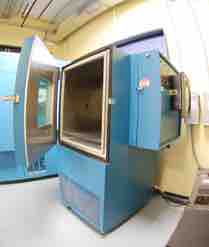Testing is the final step before commercialization. The objective is to test all the variabilites in the marketing plan including elements of the product. Test marketing represents an actual launching of the total marketing program, but on a limited basis.
Three general issues are addressed through test marketing. First, the overall workability of the marketing plan is assessed. Second, alternative allocations of the budget are evaluated. Third, whether the new product is inspiring users to switch from other brands is determined. In the end, the test market should include an estimate of sales, market share, and financial performance over the life of the product.

Product Testing
This is a photo of a temperature and humidity chamber used to simulate transport, warehouse environments, and shelf life conditions of a packaged product.
Initial product testing and test marketing are not the same. Product testing is totally initiated by the producer. He or she selects a sample of people, provides the consumer with the test product, and offers the consumer some sort of incentive to participate. Test marketing, on the other hand, is distinguished by the fact that the test cities should represent the national market. The consumer must make the decision him- or herself, must pay with his or her money, and the test product must compete with the existing products in the actual marketing environment. For these and other reasons, a market test is an accurate simulation of the national market and serves as a method for reducing risk. It should enhance the new product's probability of success and allow for final adjustment in the marketing mix before the product is introduced on a large scale.
However, running a test marketing simulation has inherent risks. First, there are substantial costs in buying the necessary plant and machinery needed to manufacture the product or locating manufacturers willing to make limited runs. There are also promotional costs, particularly advertising and personal selling. Although not always easy to identify, there are indirect costs as well. For example, the money used to test market could be used for other activities; in other words, there is an opportunity cost. There is also a risk of losing consumer goodwill through the testing of an inferior product. Finally, engaging in a test market might allow competitors to become aware of a new product and quickly copy it.
Because of the special expertise needed to conduct test markets and take on associated expenses, most manufacturers employ independent marketing research agencies with highly trained project directors, statisticians, psychologists, and field supervisors. Such firms assist the product manager in making the remaining test market decisions. These include:
- Duration of testing: the product should be tested long enough to account for market factors to even out, allow for repeat purchases, and account for deficiencies in any other elements in the new product (three to six months of testing may be sufficient for a frequently purchased and rapidly consumed convenience item).
- Selection of test market cities: the test market cities should reflect the norms for the new product in such areas as advertising, competition, distribution system, and product usage.
- Number of test cities: should be based on the number of variations considered (i.e., price, package, or promotion), representativeness, and cost.
- Sample size determination: the number of stores used should be adequate to represent the total market.
Even after all the test results are in, adjustments in the product are still made. Additional testing may be required, or the product may be discontinued.